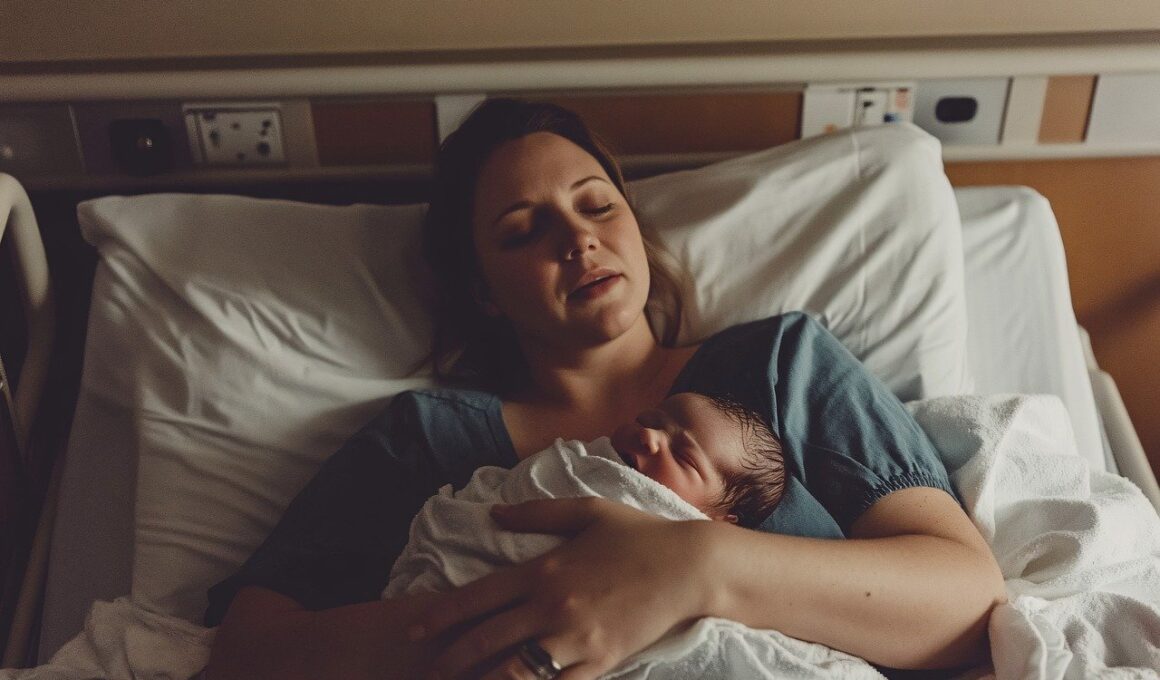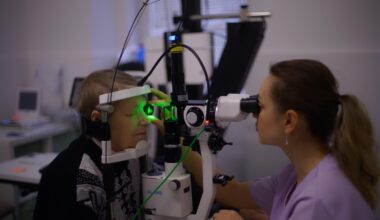How to Set Realistic Postpartum Fitness Goals
Setting realistic fitness goals postpartum is crucial for new mothers. After childbirth, the body goes through significant changes. As you transition into motherhood, it’s essential to remember that recovery takes time and patience. Instead of jumping back into intense workouts, focus on gentle exercises that promote healing and well-being. Start by incorporating walking into your routine, gradually increasing the distance and intensity. Listen to your body, and allow adequate recovery periods. It’s important to acknowledge how your energy levels may fluctuate. Establishing goals that are flexible is beneficial. Consider including both short-term and long-term goals, helping you remain motivated throughout the journey. Short-term goals may include daily walks, while long-term ones could consist of completing a fitness class. Research shows that setting specific, measurable goals supports accountability, keeping you on track to your fitness journey. Share your goals with friends or join a fitness group tailored for postpartum women. Communication can greatly enhance motivation. Lastly, celebrate small victories to maintain your enthusiasm. Progress is personal and should reflect your capabilities and commitment to a healthier lifestyle.
After childbirth, understanding your body’s limitations becomes necessary for setting goals. Hormonal changes and physical adjustments can affect your overall fitness. As you prioritize postpartum workouts, it’s essential to focus on core strength, stability, and flexibility. Incorporate exercises like pelvic tilts, bridges, and modified planks to engage your core while being gentle. Additionally, consider your mental well-being; it plays an integral role in your motivation. Set psychological goals such as practicing self-compassion throughout your fitness journey. Avoid comparing yourself with others; every journey is unique. It can be helpful to acknowledge the progress of others, but remember the importance of your own timeline. Track your workouts and feelings in a journal to reflect back on your evolving abilities and thoughts. By doing this, you gain insight into your progress and can adjust your goals accordingly. Joining postpartum workout classes or online groups might help as you seek encouragement from others experiencing similar challenges. Share your struggles and achievements in these forums. The community can be a wonderful motivator. Each little step forward is worth celebrating, so acknowledge every victory however small.
Rather than aiming for an ideal body shape, focus on functionality and overall health. Emphasize how your body feels during and after physical activities. By honoring the capabilities of your body, you prioritize health over aesthetic goals. Strength training can be especially beneficial, as it helps tone muscles and improve endurance. Actions like carrying your baby or engaging in daily activities will feel easier with an increased fitness level. It’s also essential to remember that nutrition plays a significant role in postpartum recovery. Consuming a balanced diet packed with necessary vitamins and minerals will support your fitness endeavors. Focus on whole foods—vegetables, protein, and healthy fats—to fuel workouts effectively. Avoid restrictive diets that may fail to provide sufficient energy. Additionally, hydration cannot be overlooked. Proper hydration can enhance overall well-being and performance during fitness activities. Conducting cooking sessions with friends or family can make meal preparation enjoyable and engaging. Consider focusing on meal prep for the week ahead. Also, ensure that you’re taking supplements if necessary, as directed by your healthcare provider. Overall health will support fitness goals both in body and mind.
Involve Your Family
Engaging your family in your fitness journey can build a support system that enhances accountability. As a new mother, you may have limited time. Thus, involving your children or partner in physical activities can create quality bonding moments. Try family-friendly workouts like outdoor walks, bike rides, or home workout sessions. Making fitness enjoyable for everyone encourages everyone to incorporate healthy habits into daily routines. You could also schedule regular family fitness time, ensuring fitness becomes a fun tradition. When your family joins the activity, it fosters an encouraging environment. Children often enjoy various physical activities, like playing in the park or going for hikes. Include your babies in a stroller during park runs or walking sessions. Consider using straps or carriers designed for exercises with infants, creating a chance for gentle workouts. Involving your partner can also share responsibilities, thus enhancing your emotional well-being. Agreement and encouragement from your family can significantly improve your motivation, making it easier to stick to your goals. Communication and teamwork are essential for challenges that may arise in balancing fitness with family life.
Finding a balance between fitness and the demands of motherhood may seem overwhelming, but it can be accomplished by planning. Create a weekly schedule to balance workout sessions effectively. Look for time slots where childcare can be managed, even if short bursts of exercise are the best you can fit in. Modify your workout plans based on your day; flexibility is key. Some days might allow longer durations, while others are limited to just 20 minutes. High-Intensity Interval Training (HIIT) might be a useful tool when time is short, ensuring you still receive effective workouts. Keep equipment accessible, whether it’s resistance bands, weights, or yoga mats. Having your workout spaces comfortable and inviting can make it likely you’ll stick to your scheduled sessions. Consider using fitness apps or online workouts, as they offer flexibility and guidance. Accessibility to online programs provides opportunities to workout at home without the added pressure of a gym environment. Embracing these flexible strategies can lead to lasting fitness habits while maintaining your family commitments. Remember, it’s essential to cherish this period and recognize that every step toward your goals is valuable.
Don’t neglect the importance of rest in your postpartum fitness journey. After training sessions, prioritize recovery; this is when your body rebuilds and strengthens. Incorporate yoga or gentle stretching to promote flexibility and mental relaxation. Aim for consistent sleep patterns whenever possible. Adequate sleep improves energy levels, significantly affecting your ability to engage in workouts. Listen to your body and allow rest days; overtraining can lead to burnout or injury. Furthermore, connecting with healthcare professionals can provide additional support for your fitness goals. Regular check-ins with a personal trainer or physical therapist specialized in postpartum recovery can guide your journey. They can also provide you with personalized exercise programs that ensure safe progress. Be open to modifying your routine as you progress; it’s a journey of self-discovery. Embrace the fluctuations of your goals and celebrate the journey rather than just the destination. Taking on a healthy approach full of understanding will foster a lifelong love for fitness. Surround yourself with supportive individuals who encourage wellness goals. Whether it’s friends, family, or an online group, stay connected to maintain motivation.
Embrace the Journey
Finally, it’s essential to clasp the entire postpartum fitness journey with positivity and self-acceptance. Acknowledge that every mother’s experience is distinct, with various challenges and triumphs. Celebrate each step, whether walking a few minutes longer or lifting heavier weights. Setting realistic expectations leads to a more positive mindset about fitness right after childbirth. Tracking your progress can help monitor small victories, ensuring the focus remains on achievements rather than comparisons. Sharing your stories of struggle and victory can inspire others in similar situations. Social media platforms or blogging may provide an outlet to document this experience. Create a supportive community through your engagement, where sharing becomes beneficial for all involved. Use hashtags or find local meetups that align with your fitness journey. Understanding that effective change takes time is fundamental. Rather than fixating on predetermined timelines, relish the moments spent striving toward your ideal fitness. Treat yourself with kindness and recognize that this journey might have ups and downs over time. Ultimately, the key is to foster a balance that respects your body and acknowledges its ongoing journey toward health and fitness.
In conclusion, setting realistic postpartum fitness goals involves creating an achievable blueprint tailored to your needs. Focus on integrating workouts into your life while balancing motherhood’s demands. Acknowledge that recovery takes time and adjust your approach based on your wellness. Seek support from family, friends, or communities that share similar experiences and goals. Combine fitness with nutrition to ensure whole-body health, and keep communication open with fitness professionals to guide your movement. Additionally, give importance to rest to allow your body to heal properly. Cultivate a positive mindset that celebrates the unique journey of postpartum wellness. Incorporating small victories into daily life can keep you motivated as you gradually work toward your goals. Remember, every step counts, no matter how small; be proud of the commitment to your health during this vital life stage. Embrace the support of loved ones as you embark on your fitness journey. Ultimately, honoring your body through this transition may serve as an empowering journey into motherhood. Combine fitness with emotional well-being to develop a sustainable lifestyle, reinforcing your strength both as a mom and an individual.


